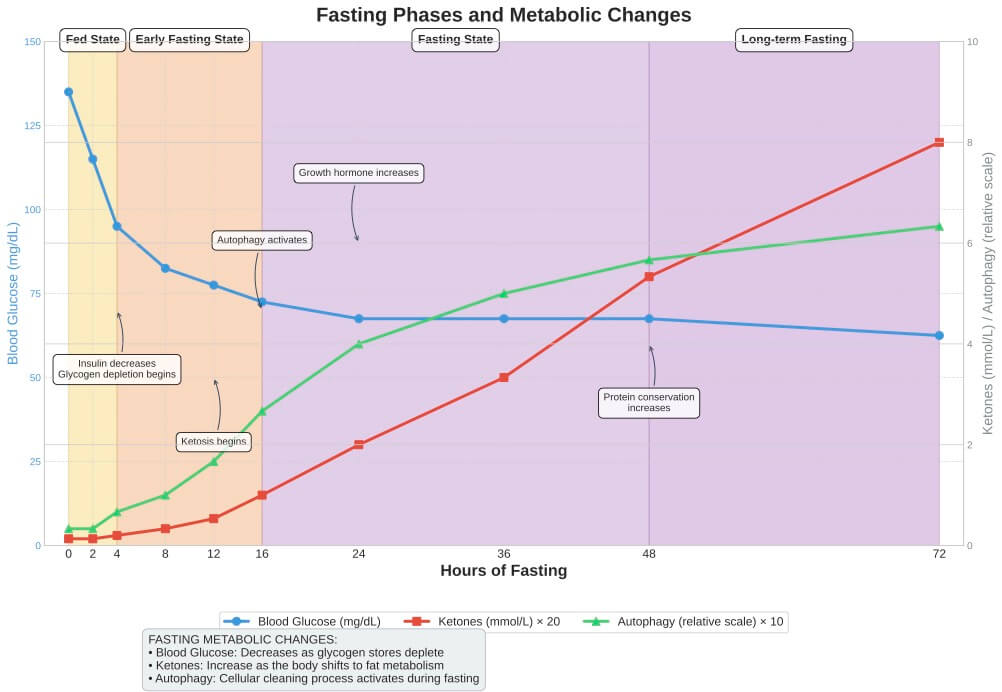This graph, entitled “Fasting Phases and Metabolic Changes,”, clearly illustrates how different metabolic parameters are transformed throughout the fasting duration. It shows a comprehensive overview of the physiological changes that occur during fasting, emphasizing the importance of understanding these phases to optimize health outcomes. For instance, it highlights the significance of transitioning from glucose metabolism to fat oxidation, which is crucial for weight management and metabolic balance.
- Blood Glucose: Levels progressively decrease, reflecting how the organism uses the available glucose and transitions to other energy sources.
- Ketone Bodies: They increase markedly after 12-24 hours, indicating that the body is beginning to burn fat as its main source of energy.
- Autophagy: This process, fundamental for cellular repair and renewal, intensifies especially after 24 hours, favoring the elimination of damaged cells and regeneration.
Overall, the chart allows you to visualize the dynamics of fasting and understand how these adaptations can promote metabolic health and longevity. It is a tool

Source: The information presented in the graph is based on a synthesis of multiple scientific sources, including Healthline articles on fasting stages, NCBI StatPearls publications on fasting physiology, PMC articles on intermittent fasting and metabolic health, and Dr. Kiltz’s detailed fasting timeline, all providing data on blood glucose changes, ketosis development, and autophagy activation during different fasting phases. Additionally, research studies have highlighted the long-term benefits of fasting, suggesting that it may play a critical role in reducing the risk of chronic diseases.
Furthermore, a deeper understanding of how fasting interacts with various hormones, such as insulin and glucagon, can provide insights into optimizing metabolic health. Insulin levels drop during fasting, which encourages fat breakdown, while glucagon works to maintain blood glucose levels effectively. This interplay is crucial for anyone looking to leverage fasting for improved health.
It’s also important to note the psychological aspects of fasting. Many individuals report enhanced mental clarity and focus during prolonged fasting periods, attributed to the increase in ketone bodies, which serve as an alternative energy source for the brain. This phenomenon has implications not only for cognitive health but also for productivity in daily activities.
Moreover, the social and cultural dimensions of fasting should not be overlooked. Various cultures incorporate fasting into their traditions, viewing it as a means of spiritual growth and community bonding. Understanding these practices can provide a holistic view of fasting beyond mere metabolic benefits.
In conclusion, understanding the phases of fasting and their metabolic implications provides valuable insights into health optimization. The adaptability of the human body during fasting presents opportunities for improved weight management, enhanced metabolic function, and greater overall well-being. As research continues to evolve, so too will our understanding of how to best utilize fasting for health benefits.
Finally, the role of hydration during fasting cannot be ignored. Staying adequately hydrated is essential for maximizing the benefits of fasting, as it aids in detoxification and supports metabolic processes. Many experts recommend drinking water, herbal teas, or electrolyte solutions during fasting periods to maintain optimal hydration without breaking the fast.




